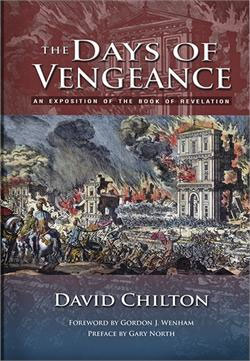Apr
10
2009
 David Field1 says the Totus Christus, the Whole Christ, is “one and many in federal union = in covenantal oneness.” It is Jesus as head and the church as His body.
David Field1 says the Totus Christus, the Whole Christ, is “one and many in federal union = in covenantal oneness.” It is Jesus as head and the church as His body.
Whenever God does something in redemptive history, the Devil produces a counterfeit. Something I have just noticed about the Revelation is another aspect to this ‘evil twin’ pattern. It is a counterfeit Totus Christus.
After the ascension of Christ, Satan was thrown down from heaven to the Land, and took up residence in Herod’s Temple as Jesus predicted (Matthew 12:45). (Notice that Jesus’ ministry as Adam was heaven-garden-heaven, and Satan’s counterfeit usurping was thus garden-heaven-garden.)
Revelation then moves into a description of two warring armies, the saints with lion faces, and the ‘bad Nazirites.’ The Jews and Judaisers as Jezebel, the false church, are finally destroyed; the true church is massacred but ascends to be with Christ “in the air.”
So the church is Christ’s permanent body. Satan’s brief possession of Judah (Land Beast/False Prophet) and Rome (Sea Beast) was the Totus Diabolus in the Land. He will not be able to do such again until he is released for a short season at the end of World history.
I guess this also means that, in response to the marriage supper of the Lamb, and the faithfulness of Christ to His bride, the best Satan could manage was a one night stand.
1 http://davidpfield.blogspot.com/2006/10/totus-christus.html
Comments Off | tags: David Field, In the air, Jezebel, Nazirite, Satan | posted in Biblical Theology, The Last Days, Totus Christus
Apr
10
2009
Counter-FEET
The gospel was on its way to conquering the Roman empire. Jewish persecution had failed (read Acts). A flood of false doctrine had failed (read the later epistles for the fight). So Satan used persecution from a Jew-Gentile conspiracy to persecute the new church.
The thought is this:
The feet of the statue in Daniel 2 became Satan’s answer to the by-now successful “intermarriage” of Jews and Gentiles in one body, the Christian church. As a Jew-Gentile conspiracy, the metal man became an evil twin of Paul’s Jew-Gentile Tabernacle. With unclean feet of Roman iron intermarried with Edomite (red) clay, Judaism became the church of Esau.
(For more, see Esau’s Ladder).
Comments Off | tags: Compromise, Daniel, Genesis, Satan | posted in Biblical Theology, The Last Days, Totus Christus
Apr
10
2009
“Danger!” the dispensationalist pundits are shouting. “Watch out for replacement theology!” This specter of “replacement theology,” also masquerading under the pseudo-academic moniker “supersessionism,” looms ominously over Christendom. One blogger blogs, “One of the most dangerous and subversive doctrines held by adherents of Preterism, is the view that in A.D. 70, at the destruction of Jerusalem by the Roman armies, God’s covenant nation of Israel was superseded by the Christian church.” A website adds, “There is a demonic cancer coursing through the life blood of the Church of Jesus Christ and its name is REPLACEMENT THEOLOGY.” Yet another puts it bluntly, “This is a heresy . . .” Joel McDermon, Replacing Replacement Theology
Fight terminology with terminology. Throughout the Bible it is clear that God’s priestly nation went through many death-and-resurrection renewals. No one calls those ‘replacements.’ Can you imagine theologians arguing that Ezra’s Temple and Nehemiah’s new Jerusalem were only a temporary parenthesis, and that God would give Israel back their old kingdom?
The same thing exactly happened in the first century. Israel died and was resurrected anew. So, I propose new jargon – ‘Transformation Theology: don’t stay left behind.’
Comments Off | tags: Dispensationalism, Ezra, Nehemiah, Replacement Theology | posted in Biblical Theology, The Last Days, The Restoration Era
Apr
10
2009
Land.

I read David Chilton’s The Days of Vengeance in 1989, and it sure surprised me to learn that the word ‘earth’ in the Bible also means ‘land.’ This simple fact alters the scope of John’s Revelation entirely. It is about God’s ending of the Covenant He restored after the Babylonian captivity, and so first century Judah is the main subject. It was a repeat of events in Jeremiah’s day, so let’s backtrack a little…
Continue reading
15 comments | tags: AD70, Bible history, Compromise, David Chilton, Dispensationalism, Exile, Ezekiel, Noah, Resurrection, Temple | posted in Against Hyperpreterism, Biblical Theology, The Last Days, The Restoration Era
Apr
10
2009
 A comment from David Hagopian on the recent pub debate between atheist Christopher Hitchens and Pastor Doug Wilson:
A comment from David Hagopian on the recent pub debate between atheist Christopher Hitchens and Pastor Doug Wilson:
There was a moment when Hitchens hit Doug with the old, “Jesus didn’t fulfill his words in Mathew 24.” It was an amazing response by Doug. Very authoritative on this section of Scripture being a description of the destruction of the temple in A.D. 70. Really powerful. You could hear multiple pin drops in the room between Christopher and Westminster profs and students. The hair on my arms stood up. Hitchens was stunned. He never again in debates brought up Scripture. Powerful stuff.
Gary DeMar writes:
“Can you imagine how a futurist would attempt to deal with Matthew 24? “Well, Jesus didn’t really mean ‘this generation,’ that is, that first-century generation. He was really referring to a future generation. Yes, ‘this generation’ does always mean the generation to whom Jesus was speaking everywhere else in the gospels, but it doesn’t mean that here. It might mean ‘race’ or ‘a future generation that sees these signs.’” Instead of hearing pins drop, there would have been out-loud laughing and dismissal.”
Full article here.
Comments Off | tags: Apocalyptic, Atheism, Doug Wilson, Gary DeMar | posted in Biblical Theology, Quotes, The Last Days
Apr
10
2009
Gregory Beale examined the Old Testament background of John’s claim that “this is the last hour,” tracing it mostly back to Daniel 8-12, the only place where he could locate a combination of “last” and “hour.” He claimed that John was talking about the eschatological trial that was inaugurated in his day, but one that continued through the whole church age.
It seems better to me to see it as the eschatological trial of the first century. John is (as Beale recognised) drawing on the Olivet Discourse, but there the coming of false Christs and false prophets is a sign of the end of the age, and of the destruction of the temple. The tribulation that Jesus talks about is the tribulation of the birth pangs of the new covenant. John is talking about the same event, only telling his readers that the timetable is almost completed.
Peter J. Leithart, 1 John: Last Hour, www.leithart.com
Comments Off | tags: Beale, Olivet Discourse, Tribulation | posted in Biblical Theology, Quotes, The Last Days
Apr
10
2009

“I could never believe a book that starts with a talking snake!”
The fourth beast was stronger and more terrifying than the others. Its huge teeth were made of iron, and what it didn’t grind with its teeth, it smashed with its feet. It was different from the others, and it had horns on its head – ten of them. Just as I was thinking about these horns, a smaller horn appeared, and three of the other horns were pulled up by the roots to make room for it. This horn had the eyes of a human and a mouth that spoke with great pride. Daniel 7:7-8
The Bible begins with Adam, Eve and a serpent in the garden, and ends with a false prophet (Adam), harlot (Eve) and beast (serpent) squatting in God’s house. The seed of man’s rebellion was now a fullgrown tree – a tree of death (James 1:14-15).
Animals are the tutors in the Old Testament. Man was created in God’s image, but instead imaged a beast. Adam was covered in animal skins and their blood temporarily covered his sin. The law was administered by angels, and the symbols God uses are mostly animals. As mentioned in a previous post, the three major covenants were symbolised by an ox, a lion and an eagle. The New Covenant symbol is the Man who is bread and wine. The New Covenant era is administered not by angels but by men, Christians.
But as this New Covenant era arrived, so did a false man: a being who had the eyes and mouth of a man but was really a man-mask for the Roman beast. Revelation refers to Jews as ‘men’ because, like Noah, they were the mediators. The gentiles are the ‘beasts’ who are called to submit and enter the ark of Christ (Acts 10:11-12).
As Israel’s history completed Day 6 (the Land animals and the Man predicted in Daniel 7), this false man, a beast who spoke like a man, was squatting in God’s garden. The Herodian line was a talking snake.
You can trust the Bible. There is always method in any apparent madness. God doesn’t do or allow anything without a reason.
(Balaam the false prophet was also a ‘talking snake.’ He was blind to God’s word, so God used a talking donkey to get through to him.)
Comments Off | tags: Angels, Balaam, Daniel, Genesis, Typology | posted in Biblical Theology, Creation, The Last Days
Apr
10
2009
“And I cut off the three shepherds in one month…” Zechariah 11:8
Who are these mysterious three shepherds?
Theories abound, most prominently that the Lord refers to the offices of prophet, priest and king in first century Judah. Perhaps, as with Zechariah 14, the pattern of Israel’s feasts (as outlined in Leviticus 23) structures Zechariah 11. If you look carefully you will also see the Creation week.
Continue reading
Comments Off | tags: Aaron, Feasts, Moses, Priesthood, Zechariah | posted in The Last Days, The Restoration Era
Apr
10
2009
The Bible contains some patterns that are frequently repeated. Sometimes these are inverted or reversed to make a point.
An example would be the seven feasts listed in Leviticus 23 which provide a common literary structure. Revelation 1-11 follows this heptamerous pattern, with Jesus’ ascension in 4-5 as Firstfruits. Revelation 12-19 also follows this pattern, with the rise of the false prophet and harlot as an ironic counterfeit of Firstfruits.
In Revelation 16, in the second major cycle, the “Ascension” section concerns the fall of Babylon and its internal structure is upside down to make the point. Reaching the end of this second cycle, the “Atonement” section is even more tricksy. Because the seven feasts are chiastic (symmetrical) with Pentecost at the centre (actually the scorching fire of un-Pentecost), Passover (Red Sea) and Atonement (Jordan) correspond (feast 2 and feast 6). So even though the seven bowls deconstruct the Old Covenant feasts – running through their order backwards – the “un-Passover” of bowl 6 is actually the “Atonement” Joshua-conquest of the church, the new Israel. So this bowls section is a subtle see-saw, working from 7 down to 1 for the Old Covenant, and from 1 to 7 for the New. This becomes apparent at bowl 6, when, at Un-Passover, (the new church’s day of covering) old Israel is exposed, uncovered, before God.
Amazing.
Comments Off | tags: Atonement, Feasts, Leviticus, Passover, Revelation, Typology, Un-Passover | posted in Biblical Theology, The Last Days, Totus Christus
Apr
10
2009
“Then the sixth angel blew his trumpet, and I heard a voice from the four horns of the golden altar before God, saying to the sixth angel who had the trumpet, “Release the four angels who are bound at the great river Euphrates.” Revelation 9:13-14
To purify the Land of the sins of the nation or the High Priest, the horns of the Incense Altar were smeared with blood from the sacrifice at the bronze Altar. These four angelic commanders, who were previously held back, were horns looking for blood.*
The fifth trumpet, alluding to Joel 2, had summoned clouds of Babylonian locusts (Judaisers) with hair like women (false Nazirites) from Herod’s false altar to devour the Land. Like those in Joel, these are ‘mighty men,’ the result of the compromise of the sons of God with idolatry (Genesis 6).
Now, the sixth trumpet brought a response from the true Altar of Incense—an unimaginable cloud of true Nazirites. The position of this event in the structure of the passage alludes to Joshua’s conquest of Canaan. But as a ‘Trumpet’, this was only a warning. The sixth bowl would bring the final conquest: Armageddon.
The sixth angel poured out his bowl on the great river Euphrates, and its water was dried up, to prepare the way for the kings from the sunrise.
Like the Jews returning from Babylon, and Abraham when he first entered Canaan, they crossed the great river Euphrates in their baptism into Christ. Just as Cyrus “parted” the Great River to conquer Babylon, the river of death was parted to allow the true saints to inherit the heavenly country. Old Jerusalem became Jericho – the city devoted to destruction.
This was an army of true Nazirites who had not broken their vow:
These are the ones who were not defiled with women, for they are virgins. These are the ones who follow the Lamb wherever He goes. These were redeemed from among men, being firstfruits to God and to the Lamb. (Revelation 14:4)
Instead of storming the open gates and raping the virgins, here an army of “virgins” crossed the Euphrates, stormed into Babylon and purified the daughters of men culture around them.
(*This refers to the Hebrew for corners and commanders being the same word.)
Comments Off | tags: Babylon, High Priest, Incense Altar, Joshua, Nazirite, Revelation | posted in Biblical Theology, The Last Days, Totus Christus
 David Field1 says the Totus Christus, the Whole Christ, is “one and many in federal union = in covenantal oneness.” It is Jesus as head and the church as His body.
David Field1 says the Totus Christus, the Whole Christ, is “one and many in federal union = in covenantal oneness.” It is Jesus as head and the church as His body.



























